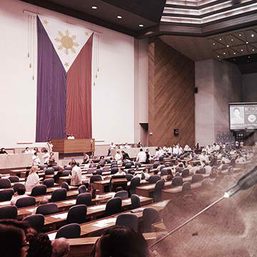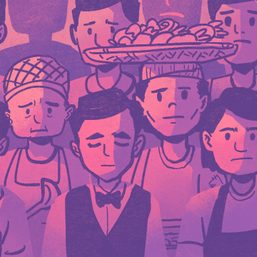SUMMARY
This is AI generated summarization, which may have errors. For context, always refer to the full article.
As the country continues to grapple with rising COVID-19 cases, several groups have opted to bring their protests online.
Since March, online protests have sprouted all over the internet: some groups have live streamed their rallies, while some took things to social media and trended hashtags that expressed their frustrations over government officials and national issues.
In other countries such as in the United States, the public has resorted to more creative means like using the popular game “Animal Crossing: New Horizons” to intensify the clamor for the #BlackLivesMatter campaign.
In the Philippines, with President Rodrigo Duterte’s 5th State of the Nation Address (SONA) just around the corner, various groups are gearing up for both online and on-ground protests to express their dissent to the government’s pandemic response, the passage of the “draconian” anti-terrorism law, and the shutdown of media giant ABS-CBN, among others.
SONA protesters are facing a challenge this year. On Friday, July 24, the Quezon City government backtracked on an earlier promise and banned physical protests in the city during SONA day on Monday, July 27. This comes after the Department of the Interior and Local Government issued a memorandum prohibiting mass gatherings during community quarantine.
The Philippine National Police is discouraging outdoor protests despite the fact that malls have reopened and dining in option has been allowed in Metro Manila under the condition that minimum health protocols are observed.
The DILG and police, however, have clarified that protests and rallies related to the SONA will still be allowed inside the University of the Philippines (UP) campuses.
Are online protests effective and a better option in expressing dissent during a pandemic?
Problem on access
Although all protests, whether done online or on-ground, have the same intention of airing out grievances, much is left to be desired for online protests as only a select few have access to them.
“[H]indi lahat may gadget, hindi lahat may internet connection, so paano natin madadala ‘yung kampanya or ‘yung panawagan ng mga communities na naghihirap ngayon sa gitna ng pandemya,” said National Union of Students of the Philippines deputy secretary-general Jandeil Rosperos.
(Not everyone has a gadget nor internet connection, so how can we air the concerns of the communities who are suffering in the midst of the pandemic?)
Marawi civic leader and former senatorial candidate Samira Gutoc called on the government to provide the necessary resources should they want all protests to be made online.
“[I]f you want us to protest online, then tell DICT (Department of Information and Communications Technology) to provide the technology…. Provide the technology if they want the online protest,” she said in an interview.
During the pandemic, protesters were arrested while holding peaceful on-ground demonstrations for allegedly “violating quarantine rules” while a government official like Metro Manila top cop Major General Debold Sinas was not punished for allowing a mass gathering – a birthday party for him – when Metro Manila was on lockdown. (Read: Cops arrest at least 8 activists at anti-terrorism bill protest in Cebu City)
‘More practical, safe’ for the ill
One advantage of an online protest, at least for people who are considered vulnerable to COVID-19, is the absence of physical contact with another person.
“[M]as iminumungkahi natin sa mga kasamahan sa iba’t-ibang grupo na may mga members na may symptoms o pagkakakilanlan ng sakit na COVID-19 na mag-stay na lang at home at maaaring lumahok na lang sa online protest,” College Editors Guild of the Philippines national secretariat Anton Narciso III said in an interview.
(We encourage those who have members who have COVID-19 symptoms to stay at home and join us on online protests instead.)
Some youth leaders believe that the advantages of the internet must be maximized to reach out to a greater audience.
Raoul Manuel said in an interview that through the internet, nationwide, coordinated social action becomes easier and possible.
“Necessary na magamit ‘yung ating creativity at iba’t-ibang resources na available sa atin para ma-express yung ating rage, ‘yung ating paglikha ng kasaysayan, at ‘yung ating pagkakaroon ng pag-asa para mabago ‘yung mga polisiya at ‘yung mismong pamamalakad na hindi na nagugustuhan ng ating mga mamamayan,” Manuel said.
(It is necessary to use our creativity and the different resources available for us to express our rage, in creating our history, and to have the hope that we can change the policies and the way our country is managed which no longer sits well with the public.)
Real change happens on-ground
Ultimately, activists argued that on-ground protests are less likely to be ignored than their online counterparts.
Rise For Education Alliance co-convenor Tierone Santos said in an interview that on-ground protests are more effective because the mobilization is visible.
He believed that while online and on-ground protests may be viewed as complementary.
Santos, along with the other groups and activists, promised to continue to seek ways to conduct on-ground mobilizations, despite arrests done during physical protests.
“We will not allow the government to shrink our democratic space to express dissent,” he said in a mix of Filipino and English. – Rappler.com
Add a comment
How does this make you feel?
![[OPINION] The narrative of Jesus’ crucifixion and the death penalty](https://www.rappler.com/tachyon/2020/07/crucified-peoples.jpg?resize=257%2C257&crop_strategy=attention)

![[OPINION] Courageous and compassionate are those who resist the tyrant’s might](https://www.rappler.com/tachyon/2020/07/courageous-those-who-resist-tyrants-might-July-30-2020.jpg?resize=257%2C257&crop_strategy=attention)


There are no comments yet. Add your comment to start the conversation.